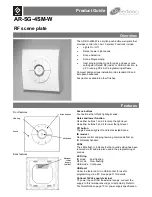
49
XMEGA B [DATASHEET]
8291B–AVR–01/2013
5.
DMAC - Direct Memory Access Controller
5.1
Features
Allows high speed data transfers with minimal CPU intervention
from data memory to data memory
from data memory to peripheral
from peripheral to data memory
from peripheral to peripheral
Two DMA channels with separate
transfer triggers
interrupt vectors
addressing modes
Programmable channel priority
From 1 byte to 16MB of data in a single transaction
Up to 64KB block transfers with repeat
1, 2, 4, or 8 byte burst transfers
Multiple addressing modes
Static
Incremental
Decremental
Optional reload of source and destination addresses at the end of each
Burst
Block
Transaction
Optional interrupt on end of transaction
Optional connection to CRC generator for CRC on DMA data
5.2
Overview
The two-channel direct memory access (DMA) controller can transfer data between memories and peripherals, and thus
offload these tasks from the CPU. It enables high data transfer rates with minimum CPU intervention, and frees up CPU
time. The two DMA channels enable up to two independent and parallel transfers.
The DMA controller can move data between SRAM and peripherals, between SRAM locations and directly between
peripheral registers. With access to all peripherals, the DMA controller can handle automatic transfer of data to/from
communication modules. The DMA controller can also read from memory mapped EEPROM.
Data transfers are done in continuous bursts of 1, 2, 4, or 8 bytes. They build block transfers of configurable size from 1
byte to 64KB. A repeat counter can be used to repeat each block transfer for single transactions up to 16MB. Source and
destination addressing can be static, incremental or decremental. Automatic reload of source and/or destination
addresses can be done after each burst or block transfer, or when a transaction is complete. Application software,
peripherals, and events can trigger DMA transfers.
The two DMA channels have individual configuration and control settings. This include source, destination, transfer
triggers, and transaction sizes. They have individual interrupt settings. Interrupt requests can be generated when a
transaction is complete or when the DMA controller detects an error on a DMA channel.
To allow for continuous transfers, two channels can be interlinked so that the second takes over the transfer when the
first is finished, and vice versa.
Summary of Contents for XMEGA B
Page 320: ...320 XMEGA B DATASHEET 8291B AVR 01 2013 Table 25 12 7 segments Character Table...
Page 321: ...321 XMEGA B DATASHEET 8291B AVR 01 2013 Table 25 13 14 segments Character Table...
Page 322: ...322 XMEGA B DATASHEET 8291B AVR 01 2013 Table 25 14 16 segments Character Table...
Page 412: ...412 XMEGA B DATASHEET 8291B AVR 01 2013...
Page 413: ...413 XMEGA B DATASHEET 8291B AVR 01 2013...
















































